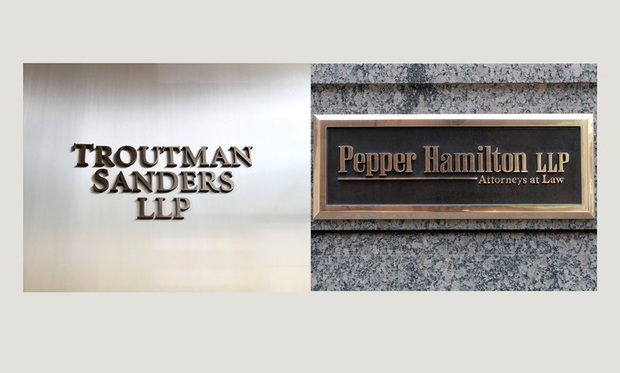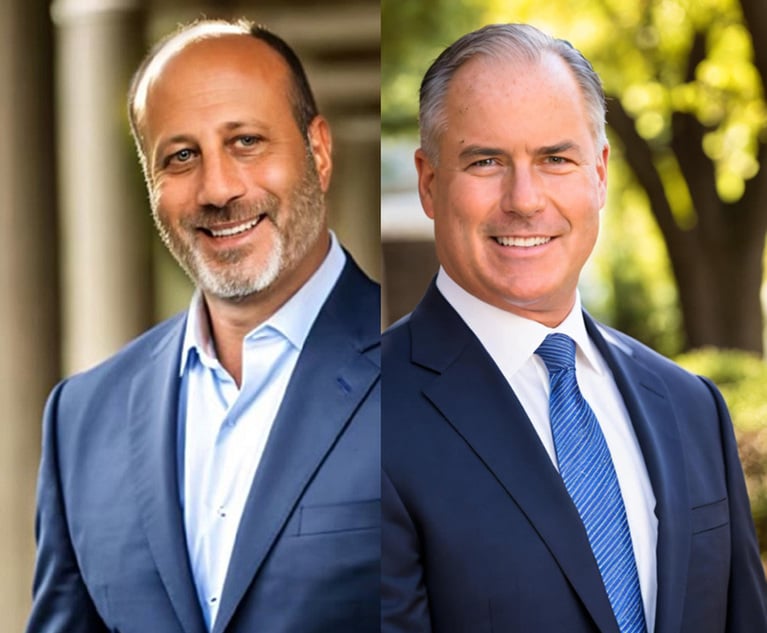In Potential Pepper Hamilton-Troutman Sanders Merger, Scale Can Be a Strategy
Troutman Sanders has already undertaken three mergers in the last two decades. Now, with a potential Pepper Hamilton tie-up, the firm could be looking to replicate its past merger gains.
November 26, 2019 at 05:41 PM
9 minute read
The original version of this story was published on Daily Report
 Troutman Sanders and Pepper Hamilton signage. (Photos: ALM and Courtesy photo)
Troutman Sanders and Pepper Hamilton signage. (Photos: ALM and Courtesy photo)
Troutman Sanders, now in tie-up talks with Philadelphia's Pepper Hamilton, is no stranger to large mergers. Troutman undertook three sizable combinations from 2001 to 2009 that expanded the firm far beyond its Atlanta roots.
Those combinations, with help from lateral recruitment, increased Troutman's revenue almost fourfold during that period, and it boosted its Am Law ranking from No. 145 in 2000 to No. 72 by 2009.
Now the firm could be looking to replicate its past merger gains. If Troutman Sanders were to combine with 450-attorney Pepper Hamilton, it could transform the firm's scale once again, in an era where its large-firm competitors are increasingly turning to mergers to build critical heft in practice areas and geography.
While the potential merger is a head-scratcher for some in the Atlanta legal market—with many recruiters and partners at peer firms saying they weren't familiar with Pepper Hamilton—legal industry observers say multiple large Am Law 200 firms are now considering mergers to try to distinguish themselves in an increasingly crowded national legal market.
Large law firms are feeling a lot of pressure to grow to build strength in key practices and locations, said Robert Brigham, a Bay Area partner at national legal recruiter Major, Lindsey & Africa, not speaking specifically about the Troutman-Pepper talks.
"Firms that are not significant in practices that matter for clients are not winning the client wars," he said, adding a merger is one way that firms can "dramatically transform themselves in a relatively short time frame."
"There are firms that on the surface seem not to need something," Brigham said. "They may be in the second half of the Am Law 100, but they don't have enough geographic reach or practice area depth."
Scale to Compete
If the Troutman-Pepper merger goes through, it would help both firms pull away from the mid-Am Law pack and vault into the Am Law 50, which are the Top 50 grossing U.S. law firms.
The deal would create a roughly 1,100 lawyer firm (with about 650 lawyers from Troutman and 450 from Pepper) with combined revenue of $855 million, based on the firms' 2018 financials.
The immediate need for greater depth and breadth, both geographically and in important practice areas, is driving firm mergers, said Lisa Smith, a principal at legal strategy consultancy Fairfax Associates, who also spoke generally.
A Troutman-Pepper merger would add heft for both firms in New York, Washington, D.C., and California. "Those are priority growth markets for firms going national, and they are markets where it's hard to get talent," Smith said.
Troutman's New York and Washington offices, at roughly 100 and 70 lawyers, respectively, are about double the size of Pepper Hamilton's offices in those cities. In California, Troutman has almost 90 lawyers in Orange County, San Diego and San Francisco, compared with about 35 lawyers for Pepper Hamilton in Orange County, Los Angeles and Silicon Valley.
Having more critical mass in New York, Washington, or even the Bay Area, could give the combined firm a leg up on recruiting key lateral partners, the consultants said.
A combination could also increase the expanded firm's experience and depth nationally in commercial litigation, corporate practices and specialty areas, such as white-collar defense, Smith said, adding that increased national scale can provide an advantage for doing middle-market work, an important part of many large firms' revenue mix since there is a limited amount of very complex, high-dollar legal work from Fortune 50 companies.
With combined resources, a larger, more national firm is better able to invest in pricing staff, technology and innovations in service to make that work feasible, even with higher overhead, Smith said. "Midsize firms may be more nimble and less expensive but they don't have the same resources to focus on that."
Merger Gains
Troutman's three earlier combinations were successful to varying degrees, but overall they increased Troutman's lawyer head count, added or expanded key practices and clients and established a national footprint. A similar expansion in scale could be motivating the firm's current merger talks.
Unlike Troutman, Pepper Hamilton, one of Philadelphia's oldest firms, has not done any comparable deals over its 130-year history. Its lawyers are concentrated in the Northeast—with about 60% of its lawyer head count in its home state of Pennsylvania.
Troutman and Pepper Hamilton spokespersons declined to comment for this story.
Troutman first merged in 2001 with a 150-lawyer Richmond firm, Mays & Valentine, creating a 450-lawyer firm, in what was the largest-ever merger for an Atlanta firm at the time.
By all accounts, that combination was a success. Troutman's only U.S. office outside Atlanta then was in Washington, and it gained four Virginia offices, complementary practices and shared clients. In the year after the merger took effect, no partners left the former Mays & Valentine in 2001 and only three left Troutman—none because of the merger.
Troutman's post-merger 2001 revenue grew 78%, boosting the combined firm from No. 145 to No. 88 in the Am Law rankings.
In 2005 Troutman bested other Big Law suitors to land a much-sought, 90-lawyer New York office in one fell swoop from now-defunct Jenkens & Gilchrist, which produced a 20% revenue spike to $249 million that year, after the April combination.
Both of those mergers were transformative—adding strong practices, such as financial services and multifamily housing law in Virginia, and ushering Troutman into the national arena.
Troutman's 2009 combination with Ross, Dixon & Bell, a 100-lawyer, Washington-based boutique handling complex commercial and insurance coverage litigation, had more mixed results. With the deal, Troutman doubled the size of its Washington office and gained footholds in Chicago and Southern California.
But the 7% revenue boost to $376 million from the deal was less than anticipated, partly because it took effect on Jan. 1, 2009, in the wake of the financial crisis. The gains from the combination were offset by a 10% decrease of lawyers firmwide from attrition and Troutman's first-ever layoffs. And in early 2017, Troutman's Chicago and Washington offices suffered the defection of 10 partners, plus associates and staff, to London-based Clyde & Co. All had joined Troutman from Ross, Dixon & Bell.
That said, Troutman still has 15 lawyers in Chicago handling insurance coverage, environmental and commercial litigation and related regulatory matters, according to its website.
Over the entire eight-year merger period, Troutman's revenue increased almost fourfold, from $101 million before the Mays & Valentine deal to $376.5 million after the one with Ross Dixon.
Post-Merger Decade
Since the 2009 combination with Ross Dixon, Troutman has expanded its U.S. footprint more gradually through lateral partner hiring. The firm has gained only four additional rungs in the Am Law ranking, to its current spot at No. 68, with little change in attorney head count, despite significant increases in revenue and profit.
The firm's revenue has increased from $376.5 million to $521.5 million since 2009, boosting revenue per lawyer from $580,000 to $809,000. Profit per equity partner has jumped from $670,000 to $1,074,000.
But by the end of 2018, Troutman had 645 lawyers—about the same as the 650 lawyers it reported at the end of 2009. Over that period, its partner head count declined slightly, from 313 partners (180 equity partners) then to 284 partners (182 equity partners).
Adding Pepper Hamilton's 450 lawyers, who generated $334 million in 2018 revenue, could be another shot in the arm for Troutmans's growth.
While Troutman has been steadily adding laterals over the last decade, numerous other large firms have been expanding by leaps and bounds.
Most recently, Minneapolis-based Briggs and Morgan has announced it will merge with Cincinnati's Taft Stettinius & Hollister, creating a 600-lawyer firm, effective Jan. 1. Another Minneapolis firm, Gray Plant Mooty just announced in October that it will merge with Kansas City, Missouri-based Lathrop Gage, creating a roughly 400-lawyer firm, also effective Jan. 1.
Several other Am Law 200 and large regional firms also are exploring mergers. Philadelphia's Drinker Biddle & Reath is in talks with Minneapolis-based Faegre Baker Daniels, for example.
"There are probably a lot more discussions going on that we're not aware of," Brigham said.
Potential Obstacles
While firms can benefit from a large-scale merger, they must clear a lot of hurdles first, the consultants cautioned. Those include cultural issues, potential client or practice conflicts and partner compensation issues.
Both Troutman and Pepper Hamilton have entertained talks in the last few years with other large firms that did not come to fruition. In 2016, Pepper Hamilton held early-stage talks with another Pennsylvania firm, Reed Smith, while Troutman last year entered, then ended talks with Dallas-based Winstead.
Smith emphasized that effective integration is key to the success of any merger. "We see some firms combine—and nothing happens," she said, adding that firms won't gain the benefit of a merger either for clients or in economic growth if their partners stay siloed and aren't able to team up to go after clients.
Still, the firms may have much to lose if they are not considering mergers.
Without scale, firms are at risk of losing rainmakers with major clients or big books of business, Brigham said, which can cause a "snowball effect," where additional key partners leave for a firm with a more national platform.
"We talk to some key lateral partners," he said, "who say they're running into limitations on their platforms—and that they will leave if their firm does not get in the 'big leagues' with more critical mass and a higher profile."
Read More:
Troutman Aims for Big Law Big Leagues With Pepper Merger
Philadelphia's 'Monster' Merger News Reflects Industrywide Zeal for Big Deals
This content has been archived. It is available through our partners, LexisNexis® and Bloomberg Law.
To view this content, please continue to their sites.
Not a Lexis Subscriber?
Subscribe Now
Not a Bloomberg Law Subscriber?
Subscribe Now
NOT FOR REPRINT
© 2025 ALM Global, LLC, All Rights Reserved. Request academic re-use from www.copyright.com. All other uses, submit a request to [email protected]. For more information visit Asset & Logo Licensing.
You Might Like
View All
Smaller Firms in 'Growth Mode' as Competition, Rates Heat Up


'Taking the Best' of Both Firms, Ballard Spahr and Lane Powell Officially Merge
6 minute read
Law Firms Mentioned
Trending Stories
- 1We Must Uphold the Rights of Immigrant Students
- 2Orrick Picks Up 13-Lawyer Tech, VC Group From Gunderson Dettmer
- 3How Alzheimer’s and Other Cognitive Diseases Affect Guardianship, POAs and Estate Planning
- 4How Lower Courts Are Interpreting Justices' Decision in 'Muldrow v. City of St. Louis'
- 5Phantom Income/Retained Earnings and the Potential for Inflated Support
Who Got The Work
J. Brugh Lower of Gibbons has entered an appearance for industrial equipment supplier Devco Corporation in a pending trademark infringement lawsuit. The suit, accusing the defendant of selling knock-off Graco products, was filed Dec. 18 in New Jersey District Court by Rivkin Radler on behalf of Graco Inc. and Graco Minnesota. The case, assigned to U.S. District Judge Zahid N. Quraishi, is 3:24-cv-11294, Graco Inc. et al v. Devco Corporation.
Who Got The Work
Rebecca Maller-Stein and Kent A. Yalowitz of Arnold & Porter Kaye Scholer have entered their appearances for Hanaco Venture Capital and its executives, Lior Prosor and David Frankel, in a pending securities lawsuit. The action, filed on Dec. 24 in New York Southern District Court by Zell, Aron & Co. on behalf of Goldeneye Advisors, accuses the defendants of negligently and fraudulently managing the plaintiff's $1 million investment. The case, assigned to U.S. District Judge Vernon S. Broderick, is 1:24-cv-09918, Goldeneye Advisors, LLC v. Hanaco Venture Capital, Ltd. et al.
Who Got The Work
Attorneys from A&O Shearman has stepped in as defense counsel for Toronto-Dominion Bank and other defendants in a pending securities class action. The suit, filed Dec. 11 in New York Southern District Court by Bleichmar Fonti & Auld, accuses the defendants of concealing the bank's 'pervasive' deficiencies in regards to its compliance with the Bank Secrecy Act and the quality of its anti-money laundering controls. The case, assigned to U.S. District Judge Arun Subramanian, is 1:24-cv-09445, Gonzalez v. The Toronto-Dominion Bank et al.
Who Got The Work
Crown Castle International, a Pennsylvania company providing shared communications infrastructure, has turned to Luke D. Wolf of Gordon Rees Scully Mansukhani to fend off a pending breach-of-contract lawsuit. The court action, filed Nov. 25 in Michigan Eastern District Court by Hooper Hathaway PC on behalf of The Town Residences LLC, accuses Crown Castle of failing to transfer approximately $30,000 in utility payments from T-Mobile in breach of a roof-top lease and assignment agreement. The case, assigned to U.S. District Judge Susan K. Declercq, is 2:24-cv-13131, The Town Residences LLC v. T-Mobile US, Inc. et al.
Who Got The Work
Wilfred P. Coronato and Daniel M. Schwartz of McCarter & English have stepped in as defense counsel to Electrolux Home Products Inc. in a pending product liability lawsuit. The court action, filed Nov. 26 in New York Eastern District Court by Poulos Lopiccolo PC and Nagel Rice LLP on behalf of David Stern, alleges that the defendant's refrigerators’ drawers and shelving repeatedly break and fall apart within months after purchase. The case, assigned to U.S. District Judge Joan M. Azrack, is 2:24-cv-08204, Stern v. Electrolux Home Products, Inc.
Featured Firms
Law Offices of Gary Martin Hays & Associates, P.C.
(470) 294-1674
Law Offices of Mark E. Salomone
(857) 444-6468
Smith & Hassler
(713) 739-1250





